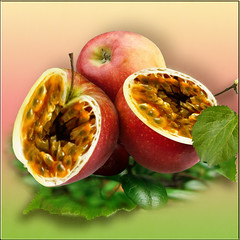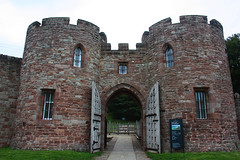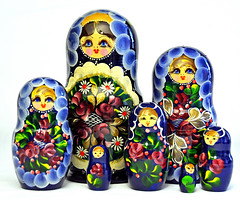
Traduzione by DANILA FORESTI, volontaria di English Gratis. Il testo originale è tratto da una pagina del sito inglese di Wikipedia ed è disponibile nel rispetto della licenza Creative Commons Attribution 2.5  photo credit: jaci XIII
photo credit: jaci XIII


Passiflora edulis (1)
Passiflora edulis (1)
Passiflora edulis is a vine species of passion flower that is native to Paraguay, Brazil and northern Argentina (Corrientes and Misiones provinces, among others).
“Passiflora edulis” è una varietà di pianta rampicante del genere “Fiore della Passione” (famiglia delle Passofloracee, 465 specie ca.) originaria del Paraguay, Brasile ed Argentina Settentrionale (province “Corrientes y Misiones”, tra le altre).
Common names include Passion Fruit (UK and US), Passionfruit (Australia and New Zealand), Granadilla (South America (In Costa Rica Granadilla is a copmpletely different fruit) and South Africa), Pasiflora (Israel), Parchita (Venezuela), Parcha (Puerto Rico), Maracudja (French Guiana), Maracujá (Brazil, Ecuador, Peru, Paraguay), Maracuyá (Peru, Colombia, Panama), Chinola (Dominican Republic), Lilikoi (Hawaiian), Magrandera Shona (Zimbabwe), Markisa (Indonesian), and L?c tiên, Chanh dây or Chanh leo (Vietnamese).
Tra i suoi nomi più comuni troviamo: Passion Fruit (Regno Unito e Stati Uniti), Passionfruit (Australia e Nuova Zelanda), Granadilla (America del Sud, salvo in Costa Rica dove “granadilla” è un frutto completamente diverso; e Sudafrica), Pasiflora (Israele), Parchita (Venezuela), Parcha (Porto Rico), Maracudja (Guyana Francese), Maracujá (Brasile, Ecuador, Perù, Paraguay), Maracuyá (Perù, Colombia, Panama), Chinola (Repubblica Dominicana), Lilikoi (Hawaii), Magrandera Shona (Zimbabwe), Markisa (Indonesia) e L?c tiên, Chanh dây o Chanh leo (Vietnam).
It is cultivated commercially in frost-free areas for its fruit and is widely grown in India, Sri Lanka, New Zealand, the Caribbean, Brazil, Colombia, Bolivia, Ecuador, Indonesia, Peru, California, Florida, Haiti, Hawaii, Argentina, Australia, East Africa, Mexico, Israel, Costa Rica, South Africa and Portugal (Azores and Madeira).
Essa viene coltivata, a scopo commerciale, per i suoi frutti, in zone al riparo dal gelo e viene ampiamente cresciuta nei seguenti Paesi e Regioni: India, Sri Lanka, Nuova Zelanda, Caraibi, Brasile, Colombia, Bolivia Ecuador, Indonesia, Perù, California, Florida, Haiti, Hawaii, Argentina, Australia, Africa Orientale, Messico, Israele, Costa Rica, Sudafrica e Portogallo (Azzorre e Madera).
The passion fruit is round to oval, either yellow or dark purple at maturity, with a soft to firm, juicy interior filled with numerous seeds.
Il frutto della passione è generalmente di forma tondeggiante o ovoidale, di colore giallo o viola scuro alla maturazione, con all’interno una polpa succosa, tra morbida e soda (gelatinosa), colma di numerosi semi.
The fruit can be grown to be eaten or for its juice, which is often added to other fruit juices to enhance the aroma.
Il frutto vero e proprio viene coltivato per essere mangiato o per il suo succo che, spesso, viene addizionato ad altri succhi di frutta per esaltarne l’aroma.
(The fruit shown are mature for juicing and culinary use.)
(I frutti presentati sono maturi per estrarne il succo e per usi culinari.)
Continue reading →

















